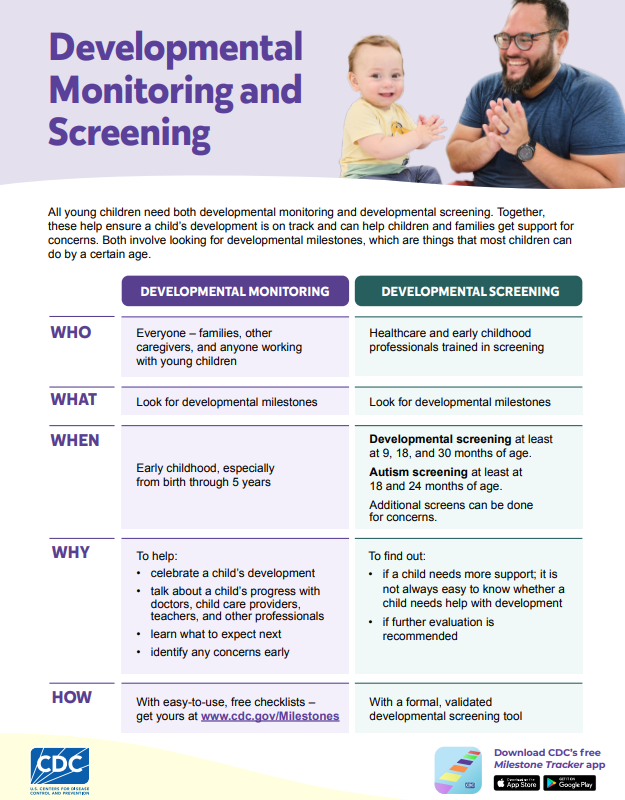Key points
- Helping families monitor their child's development enhances developmental surveillance, complements developmental screening, and improves early identification and intervention.
- Healthcare providers can engage families and support the development of children through age 5 years using CDC's milestone checklists that align with recommended health supervision visits.

Overview
Healthcare providers support families and build relationships over time during frequent well-child visits throughout infancy and early childhood. An important part of these visits is a focus on child development. Helping families understand typical child development and encouraging them to observe, support, and celebrate their child's developmental milestones over time is one of the joys of pediatric practice. These conversations are extremely important because they can also help to identify the estimated 1 in 6 children who has a developmental disability.1 Talking together when there is any developmental concern, and acting early to provide any needed supports, will help each child thrive.
CDC's Learn the Signs. Act Early. program is designed to help families understand the typical milestones of early childhood development and encourage them to "act early" on any missed milestone or concern. The milestone checklists2 and other resources were created specifically to engage families in developmental monitoring and to support their ongoing relationship with their child's healthcare provider.
Engage families in developmental monitoring
Free Learn the Signs. Act Early. resources include family-friendly developmental milestone checklists for each health supervision (well child) visit recommended by the American Academy of Pediatrics (AAP) and Bright Futures from ages 2 months through 5 years. Encouraging families to complete checklists prior to these visits can help with ongoing developmental surveillance, and support conversations about child development during visits. The checklists help families celebrate and track milestones, contain tips to support their child's development, provide guidance about what to do if they have concerns, and encourage them to talk with their child's healthcare provider. The milestones have been tested with a variety of families, have an engaging design, and are written at a fifth grade reading level.
Use milestone checklists in your practice
There are many ways to use CDC's Learn the Signs. Act Early. developmental milestone resources to engage families in the healthcare setting. Monitoring child development using the checklists is part of the ongoing developmental surveillance process3 and has proven to be an effective way to engage families during well-child visits.4 Developmental monitoring complements, but does not replace, standardized developmental screening.
Start using the milestone checklists in whatever way makes sense in your practice for the families you serve. Here are examples of strategies that have been successful in a variety of healthcare settings. They are organized in three sections that reflect increasing levels of interaction with families. Providers and staff can consider together what steps will best support families and improve developmental care.
Promote and share developmental monitoring resources
- Include messages about milestone checklists in new patient packets, newsletters, and other communications with families.
- Print and post CDC's Milestone Tracker app posters in exam and waiting rooms.
- Add a link or QR code to CDC's Milestone Tracker app to your website or patient portal.
- Share prepared social media content to promote developmental monitoring.
Directly encourage families to use the milestone checklists
- Demonstrate CDC's Milestone Tracker app during a visit, encourage the family to download and use it, and refer to it at the next visit.
- Give a Milestone Moments booklet to new patients and refer to it during future check-ups.
- Share the printed checklist for the next age as anticipatory guidance within the well visit and then refer to it during the next visit.
- Encourage use of CDC's Milestone Tracker app in the after-visit summary or other communication.
- Encourage families to use the Tips and Activities associated with each checklist in the app or printed versions.
Actively use the milestone checklists with families
- Ask families to complete a milestone checklist before each health supervision visit and then review the milestone summary with the family at the visit.
- Upon check-in, have staff encourage families to download CDC's Milestone Tracker app, use it to complete a checklist in the waiting room, and then review the milestone summary with the family.
- Laminate printed milestone checklists (so they can be wiped clean and re-used), have staff ask parents to complete them in the waiting or exam room, and then review it with the family.
- Have clinic or program staff (such as community health workers, home visitors, and WIC staff) help families download CDC's Milestone Tracker app or complete a digital or printed checklist. Encourage families to share the milestone summary and talk with you about their child's development.
- Celebrate the child's achievements when reviewing completed milestone checklists with families.
Surveillance, screening, early intervention
Learn the Signs. Act Early. helps healthcare providers engage families in ongoing developmental monitoring using milestone checklists. This makes it easier for families to share developmental progress and concerns during health supervision visits. Monitoring a child's progress using developmental milestones is also a key element of the broader ongoing developmental surveillance process that healthcare providers do in partnership with families. Developmental screening at recommended ages is also a critical part of the process health care providers use to support every child's development. Developmental surveillance and screening are different but complementary processes. They work together to engage families and help identify developmental concerns and disabilities early, so that children and families get the appropriate supports and early intervention they need.
Developmental Monitoring and Screening Overview

This video from the American Academy of Pediatrics provides an engaging and practical overview of developmental surveillance and includes the use of Learn the Signs. Act Early. resources.
Early intervention and follow-up
When a developmental concern is identified, referral for further evaluation through the state's early intervention system is often the next step. Healthcare providers, and anyone who works with young children, can refer families to early intervention for assessment and potential services. Families can also refer themselves directly. However, it is often helpful when providers make the referral and then encourage families to move forward with the process. Specific procedures and eligibility standards differ among states, so providers who have a sense of how the programs work can better help families understand what to expect.
Checking in with families to make sure they can get an initial appointment and follow through on any recommended steps is important to help support the child and family as they navigate sometimes complicated systems and services. Scheduling a follow-up appointment with the family to talk about the referrals can be extremely helpful. If a child is not eligible for a state early intervention program and the provider thinks they would benefit from a service, consider making a direct referral to appropriate therapists and/or other supports for families with young children.
Resources from American Academy of Pediatrics
The American Academy of Pediatrics (AAP) works closely with the Learn the Signs. Act Early. program to develop and share resources that support pediatricians, other child health providers, and their staff.
Developmental Surveillance and Screening Resources for Pediatricians
This dedicated AAP web page highlights resources than can support all healthcare providers and staff who work with young children and families.
Key resources include:
- Family Friendly Referral Guide
- Overview of Developmental Surveillance and Screening: How to Identify a Developmental Concern
- Establishing Trusting Relationships with Families and Caregivers through Developmental Surveillance and Screening
- Prioritizing and Facilitating Developmental Referrals
- Identifying Risks, Strengths, and Protective Factors for Children and Families: A Resource for Clinicians Conducting Developmental Surveillance
Free Child Development and Disability PediaLink Courses
This dedicated AAP webpage highlights free courses that offer CME and MOC credit. They are available to and can support all healthcare providers and staff who work with young children and families.
Key courses include:
- Innovative Strategies for Improving Developmental Surveillance and Screening
Background information
The following publications provide background related to the needs, resources, and recommendations provided on this page. Collectively, they provide context and evidence relevant to clinical practice around recommended developmental supports for young children and their families.
Prevalence and Trends of Developmental Disabilities among Children in the United States: 2009-2017 A study of the national prevalence of 10 developmental disabilities in US children aged 3 to 17 years exploring changes over time by associated demographic and socioeconomic characteristics, using the National Health Interview Survey.
Evidence-Informed Milestones for Developmental Surveillance Tools A special article documenting the process for creating the CDC's milestone checklists.
Promoting optimal development: identifying infants and young children with developmental disorders through developmental surveillance and screening An American Academy of Pediatrics Clinical Report with recommended guidance for clinicians on developmental surveillance and screening.
Impact of "Learn the Signs. Act Early." Materials on Parental Engagement and Doctor Interaction Regarding Child Development A study measuring the effectiveness of the Learn the Signs. Act Early. educational materials in increasing parent engagement in developmental monitoring during well-child visits.
Better together: Developmental screening and monitoring best identify children who need early intervention A study investigating the relationship between developmental monitoring and developmental screening in Part C early intervention service receipt.
- Zablotsky B, Black L, Maenner M, et al. Prevalence and Trends of Developmental Disabilities among Children in the United States: 2009-2017. Pediatrics. 2019 Oct;144(4): e20190811.
- Zubler J, Wiggins L, Macias M, et al. Evidence-Informed Milestones for Developmental Surveillance Tools. Pediatrics. 2022 Mar 1;149(3): e2021052138.
- Lipkin P, Macias M. Council on Children with Disabilities, Section on Developmental and Behavioral Pediatrics. Promoting optimal development: identifying infants and young children with developmental disorders through developmental surveillance and screening. Pediatrics. 2020; 145(1):e20193449
- Gadomski A, Riley M, Scribani M, et al. Impact of "Learn the Signs. Act Early." Materials on Parental Engagement and Doctor Interaction Regarding Child Development. Journal of Developmental & Behavioral Pediatrics 39(9): p 693-700, December 2018.
- Barger B, Rice C, Wolf R, et al. Better together: developmental screening and monitoring best identify children who need early intervention. Disability Health Journal. 2018;11(3):420–426.
